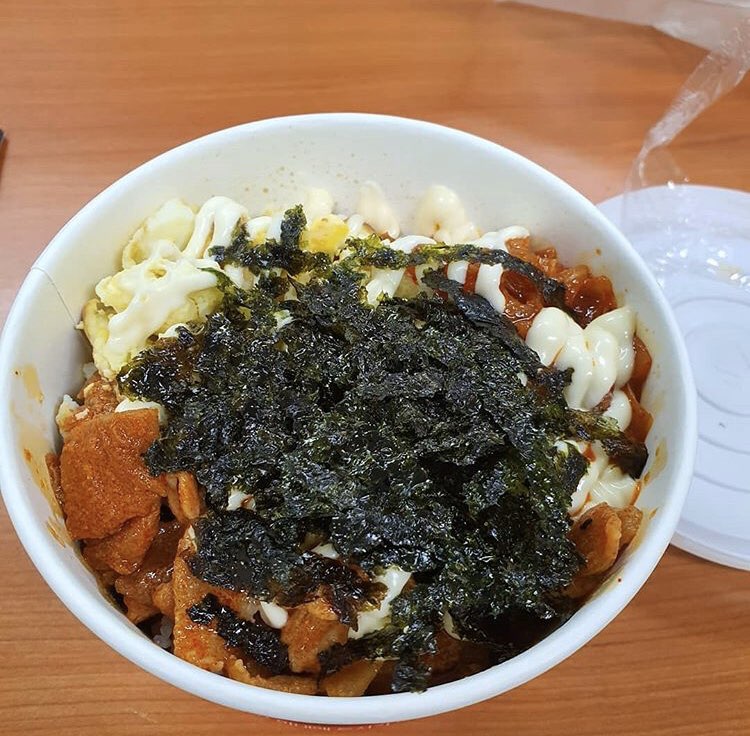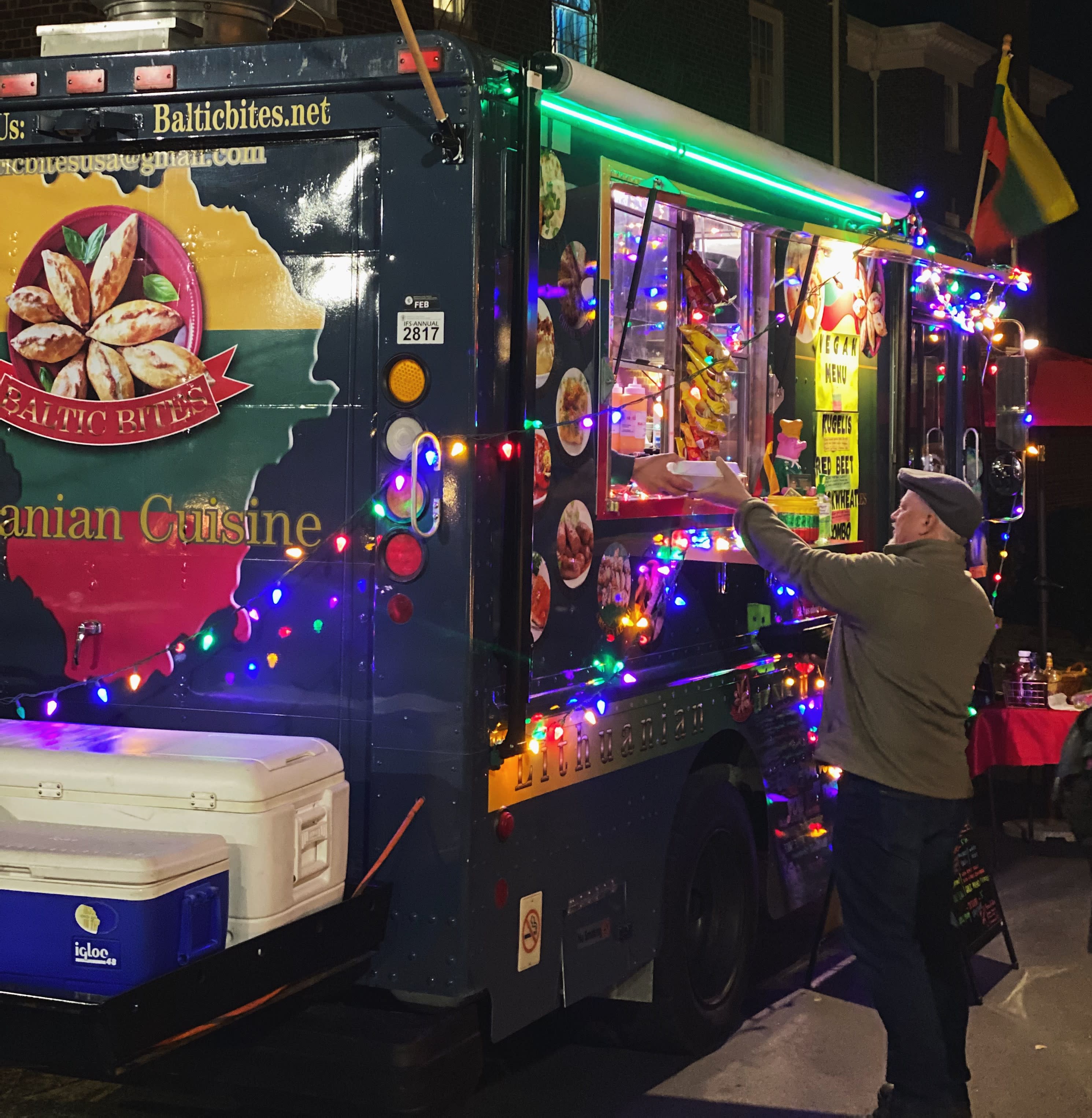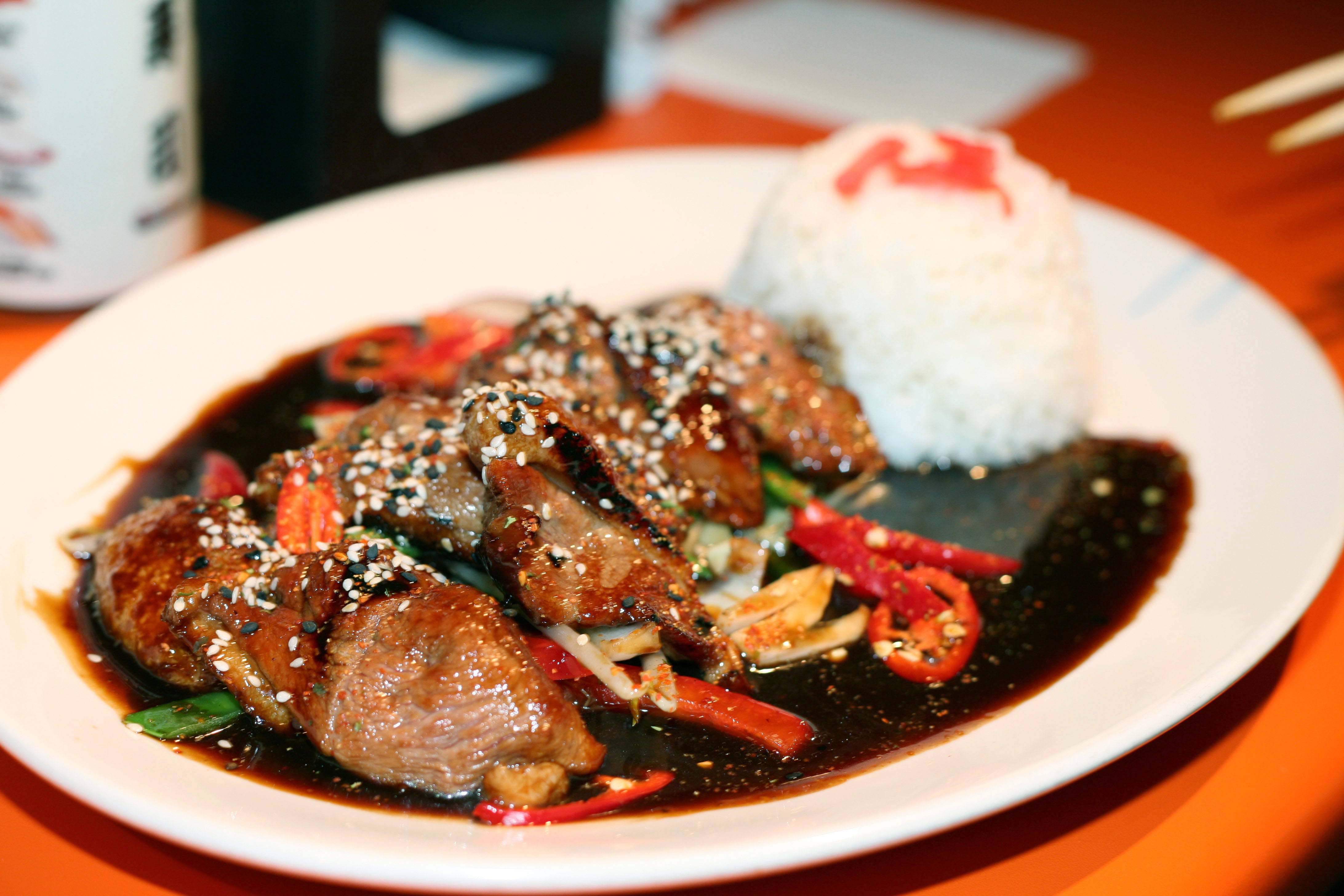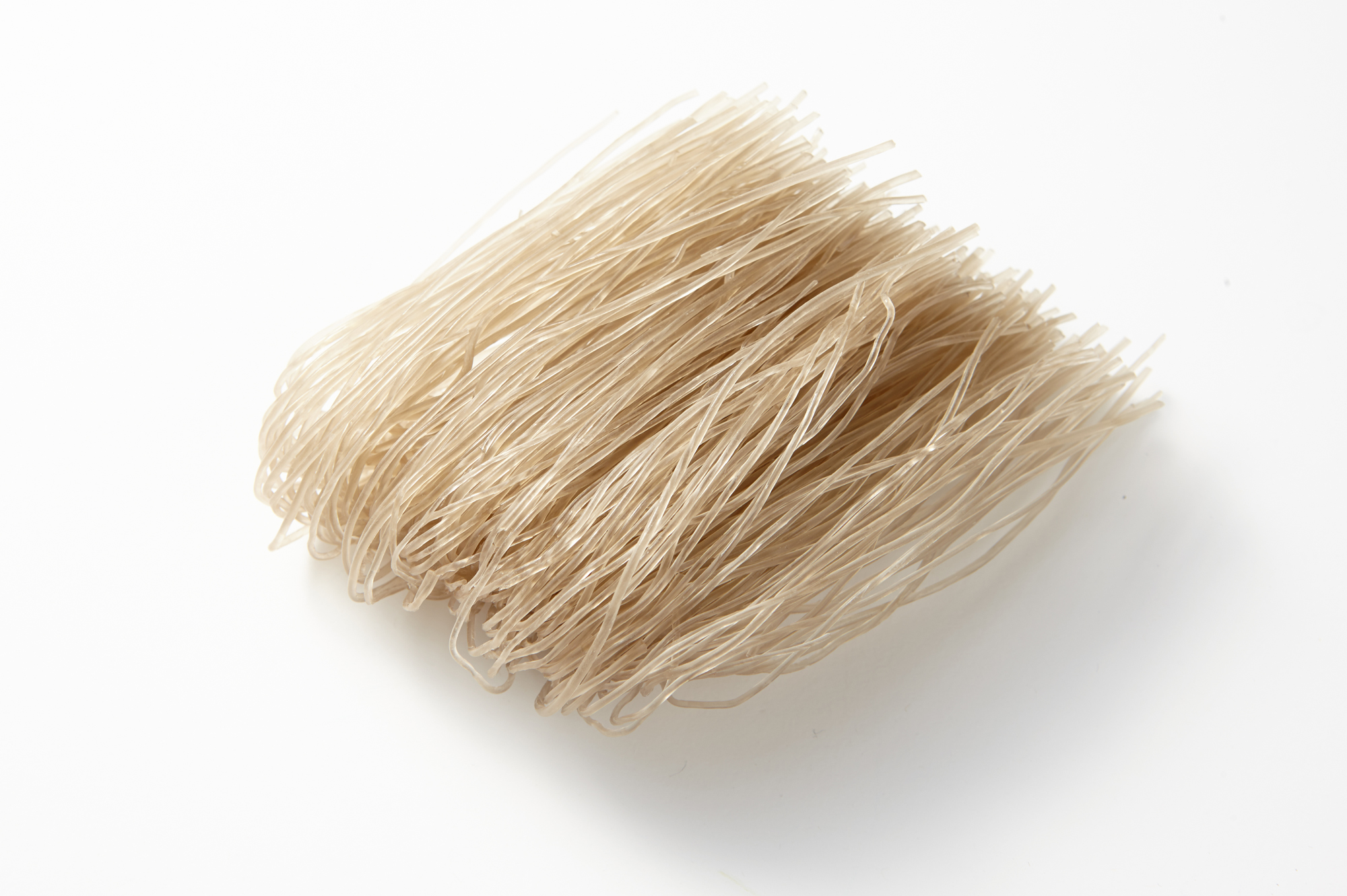|
Cup-bap
Cup-bap ( ko, 컵밥) is a food truck offering that consists of ''bap (rice dish), bap'' (rice) in a paper or plastic cup with a variety of toppings. Created in the 2000s for Korea street food, cup-bap has become a popular quick meal or snack for students from private cram schools known as hagwon, ''hagwons'' (Korean pronunciation: Help:IPA/Korean, [haɡwʌn]) in the neighborhood of Noryangjin. Definition and history In the streets of Noryangjin, many students would come out to eat at the same time which had been causing long lines at restaurants. Noryangjin had only offered very basic quick snacks such as hot dogs, so food trucks with cup-bap then filled the demand for quick, cheap, and more satisfying meals with rice, meat, and egg. Food trucks are able to quickly fill cup-bap orders, because they Stir frying, stir-fry the ingredients in advance in a large frying pan; when the cup-bap is ordered, the pre-cooked toppings are put in a cup with rice and egg. Because cup-bap is con ... [...More Info...] [...Related Items...] OR: [Wikipedia] [Google] [Baidu] |
Food Truck
A food truck is a large motorized vehicle (such as a van) or trailer, equipped to cook, prepare, serve, and/or sell food. Some, including ice cream trucks, sell frozen or prepackaged food; others have on-board kitchens and prepare food from scratch, or they heat up food that was prepared in a brick and mortar commercial kitchen. Sandwiches, hamburgers, french fries, and other regional fast food fare is common. By the early 2010s, amid the pop-up restaurant phenomenon, food trucks offering gourmet cuisine and a variety of specialties and ethnic menus became particularly popular. Food trucks may also sell cold beverages such as soda pop and water. Food trucks, along with food booths and food carts, are major components of the street food industry that serves an estimated 2.5 billion people every day. () History United States In the United States, the Texas chuckwagon is a precursor to the American food truck. In the later 1800s, herding cattle from the Southwest to markets in ... [...More Info...] [...Related Items...] OR: [Wikipedia] [Google] [Baidu] |
Teriyaki
''Teriyaki'' (kanji: 照り 焼き) is a cooking technique used in Japanese cuisine in which foods are broiled or grilled with a glaze of soy sauce, mirin, and sugar. Fish – yellowtail, marlin, skipjack tuna, salmon, trout, and mackerel – is mainly used in Japan, while white and red meat – chicken, pork, lamb, and beef – is more often used in the West. Other ingredients sometimes used in Japan include squid, hamburger steak, and meatballs. The word ''teriyaki'' derives from the noun , which refers to a shine or luster given by the sugar content in the , and , which refers to the cooking method of grilling or broiling. Traditionally the meat is dipped in or brushed with sauce several times during cooking. Teriyaki was invented by Japanese chefs in the 1600s. The is traditionally made by mixing and heating soy sauce, sake (or mirin), and sugar (or honey). The sauce is boiled and reduced to the desired thickness, then used to marinate meat, ... [...More Info...] [...Related Items...] OR: [Wikipedia] [Google] [Baidu] |
Fishery
Fishery can mean either the enterprise of raising or harvesting fish and other aquatic life; or more commonly, the site where such enterprise takes place ( a.k.a. fishing ground). Commercial fisheries include wild fisheries and fish farms, both in freshwater waterbodies (about 10% of all catch) and the oceans (about 90%). About 500 million people worldwide are economically dependent on fisheries. 171 million tonnes of fish were produced in 2016, but overfishing is an increasing problem — causing declines in some populations. Because of their economic and social importance, fisheries are governed by complex fisheries management practices and legal regimes that vary widely across countries. Historically, fisheries were treated with a " first-come, first-served " approach, but recent threats by human overfishing and environmental issues have required increased regulation of fisheries to prevent conflict and increase profitable economic activity on the fishery. Modern jurisdictio ... [...More Info...] [...Related Items...] OR: [Wikipedia] [Google] [Baidu] |
Agriculture
Agriculture or farming is the practice of cultivating plants and livestock. Agriculture was the key development in the rise of sedentary human civilization, whereby farming of domesticated species created food surpluses that enabled people to live in cities. The history of agriculture began thousands of years ago. After gathering wild grains beginning at least 105,000 years ago, nascent farmers began to plant them around 11,500 years ago. Sheep, goats, pigs and cattle were domesticated over 10,000 years ago. Plants were independently cultivated in at least 11 regions of the world. Industrial agriculture based on large-scale monoculture in the twentieth century came to dominate agricultural output, though about 2 billion people still depended on subsistence agriculture. The major agricultural products can be broadly grouped into foods, fibers, fuels, and raw materials (such as rubber). Food classes include cereals (grains), vegetables, fruits, cooking oils, meat, milk, ... [...More Info...] [...Related Items...] OR: [Wikipedia] [Google] [Baidu] |
Labelling
Labelling or using a label is describing someone or something in a word or short phrase. For example, the label "criminal" may be used to describe someone who has broken a law. Labelling theory is a theory in sociology which ascribes labelling of people to control and identification of deviant behaviour. It has been argued that labelling is necessary for communication. However, the use of the term is often intended to highlight the fact that the ''label'' is a description applied from the outside, rather than something intrinsic to the labelled thing. This can be done for several reasons: * To provoke a discussion about what the best description is * To reject a particular label * To reject the whole idea that the labelled thing can be described in a short phrase. This last usage can be seen as an accusation that such a short description is overly- reductive. Giving something a label can be seen as positive, but the term ''label'' is not usually used in this case. For exampl ... [...More Info...] [...Related Items...] OR: [Wikipedia] [Google] [Baidu] |
South Korea
South Korea, officially the Republic of Korea (ROK), is a country in East Asia, constituting the southern part of the Korea, Korean Peninsula and sharing a Korean Demilitarized Zone, land border with North Korea. Its western border is formed by the Yellow Sea, while its eastern border is defined by the Sea of Japan. South Korea claims to be the sole legitimate government of the entire peninsula and List of islands of South Korea, adjacent islands. It has a Demographics of South Korea, population of 51.75 million, of which roughly half live in the Seoul Capital Area, the List of metropolitan areas by population, fourth most populous metropolitan area in the world. Other major cities include Incheon, Busan, and Daegu. The Korean Peninsula was inhabited as early as the Lower Paleolithic period. Its Gojoseon, first kingdom was noted in Chinese records in the early 7th century BCE. Following the unification of the Three Kingdoms of Korea into Unified Silla, Silla and Balhae in the ... [...More Info...] [...Related Items...] OR: [Wikipedia] [Google] [Baidu] |
Enteritis
Enteritis is inflammation of the small intestine. It is most commonly caused by food or drink contaminated with pathogenic microbes,Dugdale, David C., IIII, and George F Longretc"Enteritis" MedlinePlus Medical Encyclopedia, 18 October 2008. Accessed 24 August 2009. such as ''serratia'', but may have other causes such as NSAIDs, radiation therapy as well as autoimmune conditions like Crohn's disease and celiac disease. Symptoms include abdominal pain, cramping, diarrhea, dehydration, and fever. Related diseases of the gastrointestinal system include inflammation of the stomach and large intestine. Duodenitis, jejunitis and ileitis are subtypes of enteritis which are localised to a specific part of the small intestine. Inflammation of both the stomach and small intestine is referred to as gastroenteritis. Signs and symptoms Signs and symptoms of enteritis are highly variable and vary based on the specific cause and other factors such as individual variance and stage of disease. ... [...More Info...] [...Related Items...] OR: [Wikipedia] [Google] [Baidu] |
Bacteria
Bacteria (; singular: bacterium) are ubiquitous, mostly free-living organisms often consisting of one biological cell. They constitute a large domain of prokaryotic microorganisms. Typically a few micrometres in length, bacteria were among the first life forms to appear on Earth, and are present in most of its habitats. Bacteria inhabit soil, water, acidic hot springs, radioactive waste, and the deep biosphere of Earth's crust. Bacteria are vital in many stages of the nutrient cycle by recycling nutrients such as the fixation of nitrogen from the atmosphere. The nutrient cycle includes the decomposition of dead bodies; bacteria are responsible for the putrefaction stage in this process. In the biological communities surrounding hydrothermal vents and cold seeps, extremophile bacteria provide the nutrients needed to sustain life by converting dissolved compounds, such as hydrogen sulphide and methane, to energy. Bacteria also live in symbiotic and parasitic relationsh ... [...More Info...] [...Related Items...] OR: [Wikipedia] [Google] [Baidu] |
Management
Management (or managing) is the administration of an organization, whether it is a business, a nonprofit organization, or a government body. It is the art and science of managing resources of the business. Management includes the activities of setting the strategy of an organization and coordinating the efforts of its employees (or of volunteers) to accomplish its objectives through the application of available resources, such as financial, natural, technological, and human resources. "Run the business" and "Change the business" are two concepts that are used in management to differentiate between the continued delivery of goods or services and adapting of goods or services to meet the changing needs of customers - see trend. The term "management" may also refer to those people who manage an organization—managers. Some people study management at colleges or universities; major degrees in management includes the Bachelor of Commerce (B.Com.), Bachelor of Business Adminis ... [...More Info...] [...Related Items...] OR: [Wikipedia] [Google] [Baidu] |
Digestion
Digestion is the breakdown of large insoluble food molecules into small water-soluble food molecules so that they can be absorbed into the watery blood plasma. In certain organisms, these smaller substances are absorbed through the small intestine into the blood stream. Digestion is a form of catabolism that is often divided into two processes based on how food is broken down: mechanical and chemical digestion. The term mechanical digestion refers to the physical breakdown of large pieces of food into smaller pieces which can subsequently be accessed by digestive enzymes. Mechanical digestion takes place in the mouth through mastication and in the small intestine through segmentation contractions. In chemical digestion, enzymes break down food into the small molecules the body can use. In the human digestive system, food enters the mouth and mechanical digestion of the food starts by the action of mastication (chewing), a form of mechanical digestion, and the wetting contact o ... [...More Info...] [...Related Items...] OR: [Wikipedia] [Google] [Baidu] |
Cambodia
Cambodia (; also Kampuchea ; km, កម្ពុជា, UNGEGN: ), officially the Kingdom of Cambodia, is a country located in the southern portion of the Indochinese Peninsula in Southeast Asia, spanning an area of , bordered by Thailand to the northwest, Laos to the north, Vietnam to the east, and the Gulf of Thailand to the southwest. The capital and largest city is Phnom Penh. The sovereign state of Cambodia has a population of over 17 million. Buddhism is enshrined in the constitution as the official state religion, and is practised by more than 97% of the population. Cambodia's minority groups include Vietnamese, Chinese, Chams and 30 hill tribes. Cambodia has a tropical monsoon climate of two seasons, and the country is made up of a central floodplain around the Tonlé Sap lake and Mekong Delta, surrounded by mountainous regions. The capital and largest city is Phnom Penh, the political, economic and cultural centre of Cambodia. The kingdom is an elective co ... [...More Info...] [...Related Items...] OR: [Wikipedia] [Google] [Baidu] |
Japchae
''Japchae'' () is a savory and slightly sweet dish of stir-fried glass noodles and vegetables that is popular in Korean cuisine. * ''Japchae'' is typically prepared with ''dangmyeon'' (당면, 唐麵), a type of cellophane noodles made from sweet potato starch; the noodles are mixed with assorted vegetables, meat, and mushrooms, and seasoned with soy sauce and sesame oil. Once a royal dish, japchae is now one of the most popular traditional celebration dishes, often served on special occasions, such as weddings, birthdays (especially '' dol'', the first birthday, and '' hwangap'', the sixtieth), and holidays. It is also popular at banquets, parties, and potlucks, due to the ease of bulk preparation and flexible serving: ''japchae'' can be served warm, at room temperature, or cold from the refrigerator, and can be eaten freshly made or the day after. ''Japchae'' is commonly served as a ''banchan'' (side dish), though it may also be eaten as a main dish. It is sometimes served o ... [...More Info...] [...Related Items...] OR: [Wikipedia] [Google] [Baidu] |








